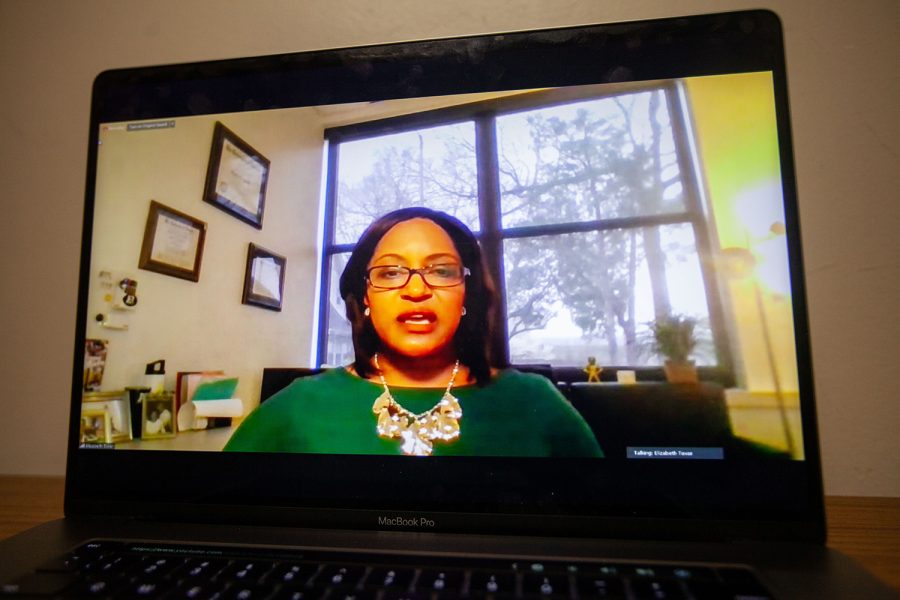Tovar: diversity, equity, and inclusion to be ‘core pillar’ in next UI strategic plan
At Tuesday’s state Board of Regents meeting, diversity, equity, and inclusion leaders from Iowa’s regents’ institutions told the regents the universities’ next steps for prioritizing initiatives for students, faculty, and staff members to better navigate inclusion issues.
University of Iowa Executive Officer and Associate Vice President for Diversity, Equity and Inclusion, Liz Tovar, speaks during an Iowa Board of Regents meeting on Wednesday, April 7. Tovar answered questions related to Diversity, Equity and Inclusion. (Ayrton Breckenridge/The Daily Iowan)
April 7, 2021
The University of Iowa will prioritize diversity, equity, and inclusion in its next strategic plan, Associate Vice President for DEI Liz Tovar told the state Board of Regents during Wednesday’s Campus and Student Affairs Committee meeting.
During the annual diversity report, Tovar and other top diversity, equity, and inclusion officials at Iowa State University and the University of Northern Iowa discussed their campus efforts and approach to inclusion.
Tovar said the UI is embedding diversity, equity, and inclusion into its strategic planning efforts as one of the institution’s “core pillars.”
“It’s our goal that in our next strategic planning process that not only will DEI be one of our core pillars, but then also, we’ll have a strategic plan that shows the intersection between DEI and other key areas such as student success and research.”
The next UI strategic plan, a roadmap for the university’s goals and improvements for the next five years, will run from 2022 until 2027. Unit strategic plans have already been collected from collegiate and departmental leaders, Provost Kevin Kregel told The Daily Iowan in March. After the process was derailed by COVID-19 in spring 2020, UI officials hope to present a plan to the regents in spring 2022 and begin implementing it in July 2022.
Tovar told the regents that the university will use more of a bottom-up approach to understand how diversity, equity, and inclusion works in individual parts of campus. One of the things the UI is working on, Tovar said, is ensuring students, faculty, and staff members understand that diversity, equity, and inclusion is not the role of one person or unit, but rather the entire campus’s responsibility.
After receiving results from the 2020 campus climate survey, Tovar said she already has ideas for potential priorities for the pillar, though did not detail any during the meeting. She said she hopes campus will allow for the data received to guide the university’s priorities.
When asked by Associate Chief Academic Officer Jason Pontius about the progress that has been made in diversity, equity, and inclusion efforts in recent years, Tovar said the growth in the diverse student population is a strive in the right direction, but the university needs to focus on hiring a more diverse faculty and staff. According to a 2020 regents report, the number of students who identify as a “racial or ethnic minority” has incrementally risen across regents institutions since 2010, rising from 11 percent in 2013 to 16 percent in 2020 of all students enrolled in the three institutions.
Of tenured and tenure-track professors at the UI, 20 percent are from underrepresented groups according to a 2020 regents diversity report. That percentage falls below the UI’s peer group — a handful of universities of similar size and structure to the UI — which is 24 percent.
“Even though the number of underrepresented minority and women doctorate recipients has grown, we have not made the same types of strides in terms of the numbers of these individuals entering institutions of higher education to become faculty,” she said. “Our students are not seeing themselves reflected in the classrooms.”
The UI has established different initiatives to address the concerns of not having as diverse a faculty as student population, Tovar said. She pointed to the UI’s Path to Distinction program through the Office of the Provost, which assists campus recruitment efforts be more intentional in seeking a diverse candidate pool.
Free Speech
Diversity, equity, and inclusion leaders at the regents’ institutions were also asked about First Amendment and freedom of speech issues on their campuses.
In the past year, the Iowa Legislature has focused on conversations and pieces of legislation to advance free speech on campuses.
As The Daily Iowan previously reported, the state House Government Oversight Committee met with University of Iowa College of Dentistry student Michael Brase, a self-described conservative, who told the committee that the college suppressed his right to free speech, causing him personal harm in the process.
Legislatures condemned the university’s handling of the situation.
Alleged free speech violations were also cited as reasons to push forward a piece of legislation that would end tenure at Iowa’s public universities.
Tovar said she is focusing on how the university can push forward students’ voices while ensuring the speech is not derogatory in any way.
“I think the difference between protected speech and speech not protected by the First Amendment is really poorly understood by faculty, staff, and students, and I think it’s really our job to help educate people,” she said. “…This is a real opportunity for us to educate college students and the folks who make up our communities on this topic.”
Students need to be unafraid to use their voice in everyday life, Tovar said, but she sees students who are unable to use their voice, which is one thing the UI intends to focus on for the next few years.
“I hear regularly around [campus] this fear to use one’s voice,” she said. “As an institution of higher education, we must graduate students who know how to use their voice for social causes…We need to arm our students with tactics for how to deal with harmful speech, whether it be in the classroom, on social media, or in their social spheres and what they can do to educate people around them.”



